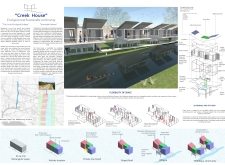5 key facts about this project
Innovative Material Application and Functional Design
One of the distinguishing elements of the Creek House is its use of recycled materials. The incorporation of corrugated sheets made from recycled Tetra Pak beverage cartons emphasizes the project’s commitment to sustainability, showcasing how innovative material choices can contribute to reducing environmental impacts. This choice aligns with the project's goals of creating a minimal carbon footprint and promoting responsible consumption.
The architectural design incorporates double-glazed panels and shutter windows to enhance thermal efficiency while ensuring ample natural light. The sloped roofs serve both aesthetic and practical purposes, facilitating rainwater collection that is redirected to storage systems. This feature not only promotes self-sufficiency but also reduces reliance on municipal water sources, contributing to the overall sustainable ethos of the project.
Flexible Community-Centric Spaces
The Creek House fosters a sense of community through its flexible spatial configurations. The design includes communal areas, such as shared kitchens and gardens, which invite residents to engage with one another while maintaining their privacy in adjacent private courtyards. This arrangement allows for varied residential experiences, where spaces can be adapted according to different needs—ranging from family living to collaborative working environments.
Additionally, the use of sliding and folding shutter doors enhances adaptability, as residents can modify their environmental interactions based on daily requirements or seasonal changes. Such design strategies promote livability and comfort, addressing the dynamic needs of modern urban dwellers.
Innovative Sustainable Features
The project incorporates several unique sustainable features that enhance its architectural significance. The inclusion of bio-toilets and rainwater harvesting systems exemplifies a commitment to sustainability and self-sufficiency. These features not only mitigate water usage but also emphasize the project's dedication to a circular economy by reducing waste and enhancing ecological conservation.
Solar panels integrated into the design further reinforce energy efficiency, providing renewable energy to the residents and contributing to a reduction in carbon emissions. By prioritizing green technologies, the Creek House serves as a practical example of how architectural design can successfully blend environmental responsibility with modern living.
Readers interested in exploring the architectural plans, sections, and designs of the Creek House are encouraged to review the project presentation to gain a comprehensive understanding of the innovative ideas and functional approaches that define this forward-thinking development. Detailed insights into the architectural elements will provide a deeper appreciation for the integration of sustainability and community living within urban settings.























